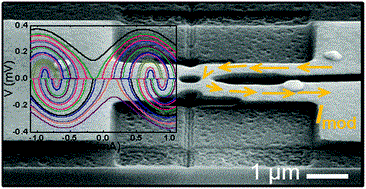
YBa2Cu3O7 nano superconducting quantum interference devices on MgO bicrystal substrates
Authors: Jianxin Lin, Benedikt Müller, Julian Linek, Max Karrer, Malte Wenzel, Maria José Martínez-Pérez, Reinhold Kleiner and Dieter Koelle
Nanoscale, 2020, 12, 5658
Abstract: We report on nanopatterned YBa2Cu3O7−δ (YBCO) direct current superconducting quantum interference devices (SQUIDs) based on grain boundary Josephson junctions. The nanoSQUIDs are fabricated by epitaxial growth of 120 nm-thick films of the high-transition temperature cuprate superconductor YBCO via pulsed laser deposition on MgO bicrystal substrates with 24° misorientation angle, followed by sputtering of dAu = 65 nm thick Au. Nanopatterning is performed by Ga focused ion beam (FIB) milling. The SQUID performance is comparable to devices on SrTiO3 (STO), as demonstrated by electric transport and noise measurements at 4.2 K. MgO has orders of magnitude smaller dielectric permittivity than STO; i.e., one may avoid Au as a resistively shunting layer to reduce the intrinsic thermal flux noise of the nanoSQUIDs. However, we find that the Au layer is important for avoiding degradation during FIB milling. Hence, we compare devices with different dAu produced by thinning the Au layer via Ar ion milling after FIB patterning. We find that the reduction of dAu yields an increase in junction resistance, however at the expense of a reduction of the critical current and increase in SQUID inductance. This results in an estimated thermal flux noise that is almost independent of dAu. However, for two devices on MgO with 65 nm-thick Au, we find an order of magnitude lower low-frequency excess noise as compared to nanoSQUIDs on STO or those on MgO with reduced dAu. For one of those devices we obtain with bias-reversal readout ultra-low flux noise of ∼175 nΦ0 Hz−1/2 down to ∼10 Hz.
